Vietnamese Food
There are basically two types of Vietnamese food: vegetarian (cơm chay) and non-vegetarian, which differ from each other simply by the ingredients used – pure vegetables or including meats. Cooked rice and other rice products are the integral parts of a Vietnamese meal, whether it is vegetarian or not. For every non-vegetarian Vietnamese dish, there is a similar vegetarian one.
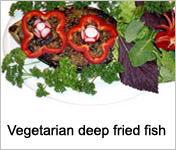
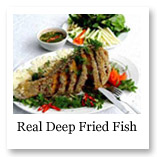
For example, a vegetarian dish in the picture on the left looks like a fried fish but the real deep fried fish is the one in the picture on the right. Some Vietnamese vegetarian dishes can be easily mistaken for meat or seafood dishes because skillful chefs can disguise their vegetable-based foods as "chicken", "shrimp", "pork", or "beef", etc.
Most Vietnamese dishes call for complimentary (but indispensable) dipping sauce (nước chấm), regardless whether the dish is vegetarian or not. Sharing the same characteristics as in the main dishes, the Vietnamese dipping sauce has a balance of the five flavours - sweetness, sourness, saltiness, hotness, and bitterness.
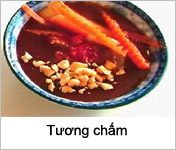
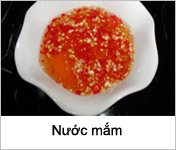 A sip of prepared Vietnamese fish sauce (nước mắm) can readily testify this claim. As dipping sauce, fish sauce is diluted with water, desalinized with lime juice
or vinegar, enhanced with hot chili and crushed garlic, and sweetened by sugar. Worth noting is the fact that in Vietnamese cuisine, unprepared fish sauce is used
for seasoning only. Bean-based dipping sauce (tương chấm) as shown on the left can be used with either vegetarian or non-vegetarian dishes.
A sip of prepared Vietnamese fish sauce (nước mắm) can readily testify this claim. As dipping sauce, fish sauce is diluted with water, desalinized with lime juice
or vinegar, enhanced with hot chili and crushed garlic, and sweetened by sugar. Worth noting is the fact that in Vietnamese cuisine, unprepared fish sauce is used
for seasoning only. Bean-based dipping sauce (tương chấm) as shown on the left can be used with either vegetarian or non-vegetarian dishes.
The Vietnamese dishes most favoured by the Vietnamese are surprisingly those that can be regarded as appetizers (món ăn chơi). Some are in the form of salads (gỏi), which are basically crunchy shredded cucumber, carrot, white radish, etc, that are quickly tossed in lime juice, vinegar and sugar. They are topped with crushed peanuts, garnished with Vietnamese coriander (rau răm) and optional slices of steamed pork, beef or seafood.
 Vietnamese spring (or imperial) rolls (chả giò) are deep fried rolls of chopped jicama, onion and garlic, minced pork, bean threads, crab meat that are all wrapped in thin rice paper (bánh tráng). When served right after being fried, they are distinctively crunchy and traditionally eaten with Vietnamese herbs and nước mắm, as suggested by the picture on the left.
Vietnamese spring (or imperial) rolls (chả giò) are deep fried rolls of chopped jicama, onion and garlic, minced pork, bean threads, crab meat that are all wrapped in thin rice paper (bánh tráng). When served right after being fried, they are distinctively crunchy and traditionally eaten with Vietnamese herbs and nước mắm, as suggested by the picture on the left.
 Vietnamese "sizzling" crepe (bánh xèo) is another popular "appetizer",
as shown in the picture on the side. The sizzling noise (xèo in
Vietnamese) occurring when the crepe mixture is poured onto a hot pan
gives the name to this dish. Variations of the ingredients and the way of
cooking of the above two dishes give rise to a large number of their
derivatives. It is up to the person who cooks to add their imagination
when selecting the ingredients, or to use whatever available locally; all of which is acceptable and that is one characteristic of Vietnamese cooking!
Vietnamese "sizzling" crepe (bánh xèo) is another popular "appetizer",
as shown in the picture on the side. The sizzling noise (xèo in
Vietnamese) occurring when the crepe mixture is poured onto a hot pan
gives the name to this dish. Variations of the ingredients and the way of
cooking of the above two dishes give rise to a large number of their
derivatives. It is up to the person who cooks to add their imagination
when selecting the ingredients, or to use whatever available locally; all of which is acceptable and that is one characteristic of Vietnamese cooking!
A popular and well known Vietnamese dish is, of course, phở, which is Vietnamese noodle
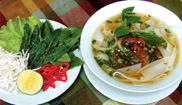 soup, cooked with either beef or chicken. Originally, it was a dish intended for breakfast only but because its contents are so filling that the dish can now be had for any time of the day. The flavour steaming from a hot bowl of phở can surely make any person hungry. Phở can be eaten by itself, or with Vietnamese herbs and bean sprouts; see the picture on the side,
soup, cooked with either beef or chicken. Originally, it was a dish intended for breakfast only but because its contents are so filling that the dish can now be had for any time of the day. The flavour steaming from a hot bowl of phở can surely make any person hungry. Phở can be eaten by itself, or with Vietnamese herbs and bean sprouts; see the picture on the side,
As you travel across Vietnam you will find other similar noodle soups; for example;
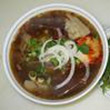
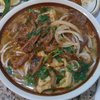 Bún Bò Huế (Beef Noodle Soup, Huế style) originated in the 19th-century capital of Vietnam - Huế. The dish in the picture on the left is cooked with beef, enhanced with red chili paste; while the dish on the right is totally vegetarian. Other examples include hủ tiếu (pork noodle soup), bún nước lèo (noodle soup with fish, shrimp and pork), bún thang (chicken noodle soup), etc.
Bún Bò Huế (Beef Noodle Soup, Huế style) originated in the 19th-century capital of Vietnam - Huế. The dish in the picture on the left is cooked with beef, enhanced with red chili paste; while the dish on the right is totally vegetarian. Other examples include hủ tiếu (pork noodle soup), bún nước lèo (noodle soup with fish, shrimp and pork), bún thang (chicken noodle soup), etc.
Bún is also a type of dish served with cold rice vermicelli (without soup), mixed with fresh herbs, pickle carrots (đồ chua), charcoal-grilled meat or fish, and garnished with fried chopped green onion and crushed peanuts. The meat is marinated with garlic, sugar, fish sauce and lemongrass.

 The meat is either skewered, as shown on the left, or wrapped in wild betel leaves (lá lốt) before being grilled, as shown on the right. Notice the folding grill in the picture on the right, which can hold together small pieces of meat and it allows easy turnover during grilling.
The meat is either skewered, as shown on the left, or wrapped in wild betel leaves (lá lốt) before being grilled, as shown on the right. Notice the folding grill in the picture on the right, which can hold together small pieces of meat and it allows easy turnover during grilling.
In fact, grilled meats (thịt nướng) are Vietnamese delicacies and numerous restaurants in Vietnam serve mainly these delicacies. You can order already-grilled meat dishes, or you can grill them yourselves at your table. Alternatively, you can order dishes of meats that are stir-fried with lemongrass and hot chili such as lươn xào xả ớt (eel), or with curry and peanut ếch xào lăn (frog), etc.
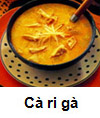
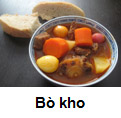 Some Vietnamese dishes reflect the history of Vietnam. For example, the Vietnamese curry (cà ri) bears some resemblance with Malaysian curry - as the Vietnamese moved South from China; and the Vietnamese beef stew (bò kho) can remind people of ragoût de boeuf – as Vietnam was a French colony for more than one hundred years.
Some Vietnamese dishes reflect the history of Vietnam. For example, the Vietnamese curry (cà ri) bears some resemblance with Malaysian curry - as the Vietnamese moved South from China; and the Vietnamese beef stew (bò kho) can remind people of ragoût de boeuf – as Vietnam was a French colony for more than one hundred years.
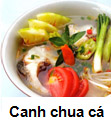
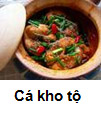
Some other dishes are uniquely Vietnamese, such as canh chua cá bông lau (fish sweet and sour soup – "cá bông lau" is a special fish specie in the Mekong river), cá kho tộ (literally – braised fish in clay pot), canh rau đay (soup of saluyot (jute) leaves), etc. "Canh chua" is not cooked with lemongrass and basil as in Thai sweet and sour soup. On the other hand, its ingredients such as pineapple, okra, tomatoes and bac ha must be practically raw and crunchy when served. It is more interesting to watch the video clip on how to cook "cá kho tộ" (click here) than to read its description. The soup base in canh rau đay is cooked with water and crushed crabs. The solid part of the soup base is to be discarded before adding saluyot leaves and shrimp paste.
Turning to fast foods, most Vietnamese fast foods have their names starting with "bánh" as in "bánh xèo". "Bánh xèo" and a few others (bánh bèo, bánh cuốn, etc.) must be consumed while seated because they are eaten with nước mắm (unless you want to risk yourself with spilling fish sauce on your clothes!). Other "bánh"s can be eaten "on the run"; for example: bánh giò, bánh mì thịt (also known as Vietnamese submarines). Perhaps, the most "sacred" bánh is bánh tét (or bánh chưng) that, traditionally, is the main and indispensable dish in Vietnamese homes on the New Year Day. It is the food that was "invented" by Vietnamese thousands of years ago and passed on generations to generations. Amazingly, "bánh tét/chưng" can be kept for weeks, if not months, without refrigeration, even in the hot climate of Vietnam.
Another member of the "bánh" family is bánh ngọt (literally – sweet cakes. or pastries). Some of them have names that are French-like: bánh flan, bánh su (choux); or are French-like but with Vietnamese names such as bánh bông lan. Numerous others are purely Vietnamese; for example, bánh xu xê, bánh khoai mì, bánh bò nướng, bánh đúc lá dứa, etc. It is interesting to note that some of the "bánh"s (e.g. bánh đúc) can be either sweet (for deserts), or have meat stuffing (for snacks).
 Finally, thanks to the abundance of tropical fruits, desserts in Vietnam can be simply any fruits within reach. In formal parties, however, fruits must be arranged in some attractive and artistic ways. On the left is the front page of a Vietnamese book on How To Arrange Fruits. In reality, fruits are often arranged in such a way to achieve a balance of colours, or in a combination with names meaning something nice, of which the famous one is "dừa (coconut), đủ (papaya), xoài (mango)" – that sounds like "enough to survive" in Vietnamese.
Finally, thanks to the abundance of tropical fruits, desserts in Vietnam can be simply any fruits within reach. In formal parties, however, fruits must be arranged in some attractive and artistic ways. On the left is the front page of a Vietnamese book on How To Arrange Fruits. In reality, fruits are often arranged in such a way to achieve a balance of colours, or in a combination with names meaning something nice, of which the famous one is "dừa (coconut), đủ (papaya), xoài (mango)" – that sounds like "enough to survive" in Vietnamese.

The above shows an animation collage images of vietnamese food.
(You must have Adobe Flash Player installed to view the animation. Visit http://get.adobe.com/flashplayer/ to install this player)




